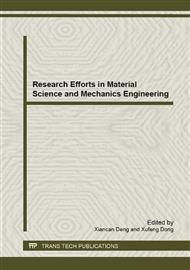[1]
M. Palacios and F. Puertas, Adsorption of water reducer admixtures on alkali-activated slag pastes, Cement and Concrete Research 39 (2009) 670–677.
DOI: 10.1016/j.cemconres.2009.05.005
Google Scholar
[2]
T. Bakharev, J.G. Sanjayan and Y.B. Cheng, Alkali activation of Australian slag cements, Cem Concr Res 29 (1999) 113–120.
DOI: 10.1016/s0008-8846(98)00170-7
Google Scholar
[3]
T. Bakharev, J.G. Sanjayan, Y. -B. Cheng., Effect of admixtures onproperties of AAS concrete, submitted for publication in Cem ConcRes (1998).
Google Scholar
[4]
F.G. Collins, J.G. Sanjayan, Workability and mechanical propertiesof alkali activated slag concrete, Cem Conc Res 29 (3) (1999) 455–458.
DOI: 10.1016/s0008-8846(98)00236-1
Google Scholar
[5]
C. Shi, Strength, pore structure and permeability of alkali-activated slag mortars, Cem Concr Res 26 (1996) 1789–1799.
DOI: 10.1016/s0008-8846(96)00174-3
Google Scholar
[6]
A. Fernández-Jiménez and F. Puertas, Effect of activator mix on the hydration andstrength behaviour of alkali-activated slag cements, Adv Cem Res 15 (3) (2003)129–136.
DOI: 10.1680/adcr.2003.15.3.129
Google Scholar
[7]
T. Bakharev, J.G. Sanjayan and Y.B. Cheng, Resistance of alkali-activated slag concrete toacid attack, Cem Concr Res 33 (2003) 1607–1611.
DOI: 10.1016/s0008-8846(03)00125-x
Google Scholar
[8]
F. Puertas, R. Mejía de Gutierrez and A. Fernández-Jiménez, S. Delvasto, J. Maldonado, Alkaline cement mortars, Chemical resistance to sulfate and seawater attacking, Mater Constr 52 (267) (2002) 55–71.
DOI: 10.3989/mc.2002.v52.i267.326
Google Scholar
[9]
T. Bakharev, J.G. Sanjayan and Y.B. Cheng, Effect of admixtures on properties of alkali-activated slag concrete, Cem Concr Res 30 (2000) 1367–1374.
DOI: 10.1016/s0008-8846(00)00349-5
Google Scholar
[10]
M. Palacios and F. Puertas, Effect of water reducer and shrinkage-reducing admixtures on alkali-activated slag pastes and mortars, Cem Concr Res 35 (2005) 1358–1367.
DOI: 10.1016/j.cemconres.2004.10.014
Google Scholar
[11]
F. Puertas, H. Santos, M. Palacios and S. Martínez-Ramírez, Polycarboxylate super-plasticizer admixtures. Effect on hydration, microstructure and rheologicalbehaviour in cement pastes, Adv Cem Res 17 (2005) 77–89.
DOI: 10.1680/adcr.2005.17.2.77
Google Scholar
[12]
F. Perche, Adsorption de polycarboxylates et de lignosulfonates sur poudremodèle et ciments. Thése EPFL No 3041, Lausanne. (2004).
Google Scholar


